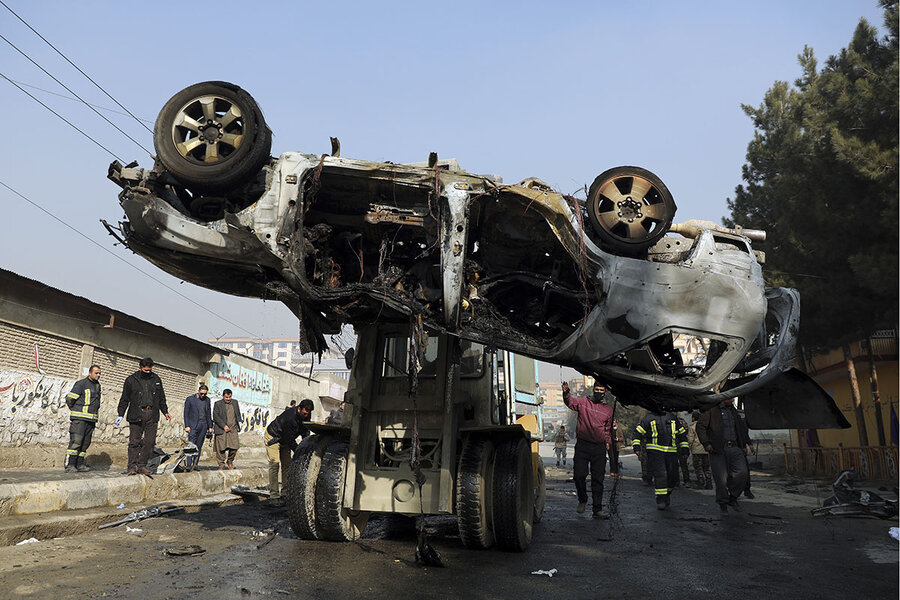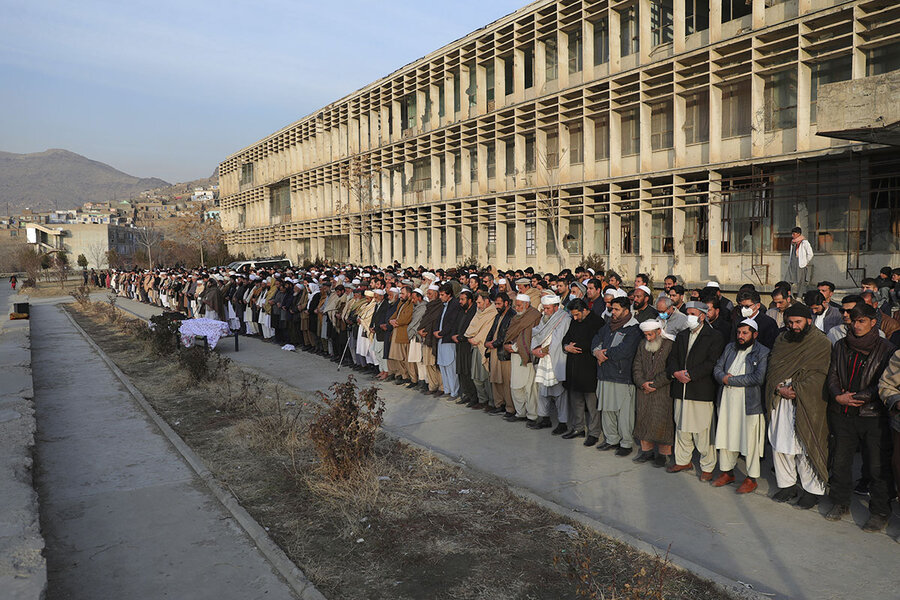By Scott Peterson
In the streets of Kabul, Shogofa Sediqi knew she was being stalked by Taliban killers.
As the chief director for Afghanistan’s Zan TV (Women’s TV), she had grown accustomed to militants sending her threats, telling her in real time what she was wearing and what time she left home, and warning her to stop her work as a journalist.
“We know you are back, at the airport,” read the first message that popped up on her phone last summer, after a month in India. Later, men waiting in a car outside her house rammed her vehicle as they tried to run her over.

Afghan security personnel remove a damaged vehicle after a deathly bomb attack in Kabul,Afghanistan,Jan,10,2021. the attach took place even as government negotiators were in Qatar to resume peace talk with Taliban.
Ms. Sediqi, like many Afghans desperate for an end to such threats and decades of war, had hoped that the danger to civil society and women’s rights posed by the Islamist Taliban would soon recede when the insurgents and government began intra-Afghan peace talks last September.
But an unprecedented surge in targeted assassinations in Kabul and other urban centers – which have left dozens of journalists, civil society activists, and officials dead, in almost daily killings since autumn – combined with sluggish peace talks and an accelerating U.S. troop withdrawal, is deflating her hope of a peaceful future.
The Taliban “have not changed”
“They are targeting journalists and civil society because they are the loud voices of the nation,” says Ms. Sediqi, whose network has been forced by a multitude of threats to stop live broadcasts and switch to recorded programing, while most staff work from home.“The Taliban is the same Taliban as before. They have not changed. They do not accept women’s activists and civil society,” says Ms. Sediqi. “The situation has become worse; we’ve lost so many. ... We don’t know who is our enemy. When we come out we don’t trust anyone.”
Few of the assassinations have been claimed, and the Taliban officially deny any role. But on Jan. 4, for the first time, the U.S. forces spokesman in Kabul explicitly blamed the Taliban, stating that its “campaign of unclaimed attacks and targeted killings … must also cease for peace to succeed.”
And this week Afghan commandos reported discovery of a bomb-making center in Logar province with hundreds of mortar rounds and homemade magnetic “sticky” bombs – a tool favored for use on cars stuck in traffic – which they linked to a Taliban assassination cell known as Obaida Karwan.
Ahmad Zia Saraj, head of Afghanistan’s National Directorate of Security, told lawmakers Dec. 29 of the existence of Obaida Karwan, tasked with carrying out targeted killings, and said 70 suspects charged with that mission had been arrested. Blindfolded suspects have also been put before cameras at press conferences, to describe their role in Taliban-ordered assassinations.
Preparing for authoritarian rule
“The best way to make sense of what the Taliban are doing by taking out civil society, is it’s part of them preparing for power,” says Michael Semple, an Afghanistan expert at Queen’s University Belfast who lived and worked for years in the country.For the Taliban, the killings both spread panic and undermine confidence in the government.
“It may also be about silencing civil society,” says Mr. Semple. “The Taliban are not going to brook any criticism, either in their campaign to topple the government, or once they are busy putting in place their own regime. Don’t expect freedom of speech, when they are back.”
And the Taliban coming back, in total control – as they ruled their self-declared “Islamic Emirate of Afghanistan” in the late 1990s, with an iron hand – is the premise of current Taliban thinking, he says, despite past public statements about moderating their strict policies.
“They are setting about imposing the Taliban version of Islam … forced at the barrel of a gun,” says Mr. Semple. “From what I pick up, on their political thinking about when they take over later on in the year, they are looking at authoritarian rule. The Taliban will be solely in charge, and that means any of the old freedoms and guarantees will be gone.”
Targeted killings of officials and members of the Afghan security forces have been a frequent Taliban insurgency tactic since the jihadists were ousted from power by the United States in 2001. The Taliban now control or have influence over half the country, and field a wide network of loyal agents.
Justification for the shift to high-profile civil society targets – even as peace talks continue – is clear in recent Taliban propaganda videos. One posted by a Taliban spokesman on Twitter on Dec. 28 shows five rifle-toting, thickly bearded fighters standing in a row. One of them – citing a verse in the Quran – declares that “it is permissible to kill the [U.S.-backed] puppet regime of Kabul” because it has taken “Jews and the Christians as allies.” He says jihad against them is obligatory.
Accelerated U.S. withdrawal
Contributing to the apparent change in Taliban calculations – and slow progress at intra-Afghan talks, which resumed this week in Qatar after a recess, but without two top Taliban negotiators who failed to return – is the accelerated withdrawal of U.S. troops to 2,500 by Friday.A U.S.-Taliban withdrawal agreement signed last February committed American and NATO forces to a complete pullout by May 2021, in exchange for Taliban counterterrorism steps and ending cooperation with Al Qaeda, which the U.S. and United Nations say the Taliban have failed to do.
The U.S.-led withdrawal is meant to be conditional on the Taliban lowering levels of violence by as much as 80%, but President Donald Trump sped up the pullout, despite the Taliban’s unabated attacks, which included two massive assaults on southern provincial capitals Lashkar Gah and Kandahar last fall.Amid that violence, the intensified assassination campaign brings its own messages.

Villagers pray over the coffin of Mohammad Yousuf Rasheed, a journalist and executive director of the nongovernmental Free and Fair Election Forum of Afghanistan, at his funeral in Kabul, Afghanistan, Dec. 23, 2020. He was shot dead by unknown assailants in Afghanistan's central Ghazni province.
“All these [assassination] groups are under the control of the Taliban,” says retired Brig. Gen. Abdul Raqib Mubariz, a former commander of the Afghan Crisis Response Unit who has dealt with scores of Taliban and Islamic State attacks.
The Obaida Karwan cell – named after a Taliban commander in Logar province – is “very small,” he says, but includes many “professional people.”
The killings aim “to show the Taliban have become important, to show the world they are strong,” says General Mubariz, speaking in Kabul. “Even if there is peace, there will still be violence. The Taliban are focused on conflict … on making their own separate government.”
A woman on Taliban’s target list
Despite such concerns, U.S. Secretary of State Mike Pompeo tweeted on Jan. 2 about “incredible progress” in Afghanistan. Experts were surprised that Mr. Pompeo boasted “We did it,” given the ongoing high levels of Taliban attack.“The Taliban are going around saying, ‘We got all these things from the Americans, and gave them nothing in return. We understand the art of the deal,’” says Mr. Semple at Queen’s University Belfast.
One prominent women’s rights activist, who asked not to be named, says she received so many Taliban threats that she recently moved away for her safety.
She appeared last week on a list of 100 names, labeled the “primary target” hit list of Obaida Karwan, which circulated on social media.
“In the beginning of peace negotiations my analysis was that the Taliban changed, especially for women’s rights and lowering violence, but unfortunately my analysis was wrong,” says the activist in Kabul.
She waited in vain for a cease-fire, and now her name is published as a target.



